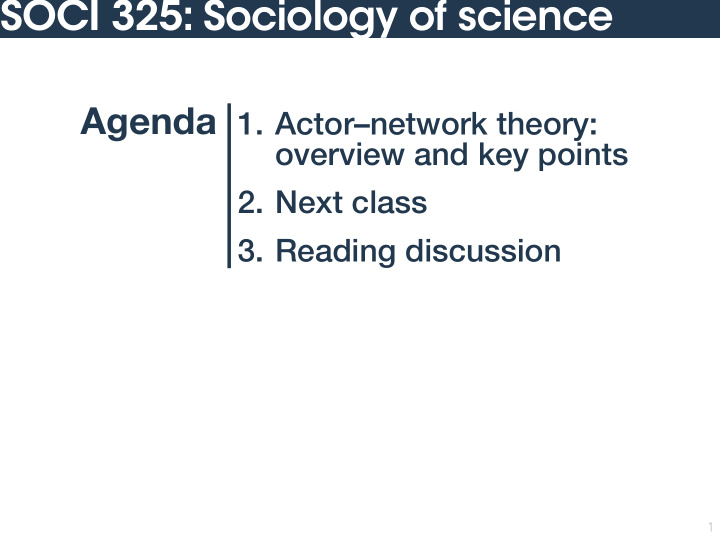



SOCI 325: Sociology of science Agenda 1. Actor–network theory: overview and key points 2. Next class 3. Reading discussion 1
: ANT overview and key points 2
Actor–network theory (ANT) Overview of ANT ANT was a new theoretical approach to studying science, emerging in the early 1980s. Notable proponents/developers of ANT: Bruno Latour; Michel Callon; John Law Broadly, ANT takes issue with the Modern idea that culture and nature are inherently distinct. According to ANT, objects do not need to be seen in relation to humans to have meaning. Since its introduction, ANT has expanded beyond STS and is used in a wide array of sociological research. 3
Actor–network theory (ANT) ANT and the Strong Programme “Supersymmetric” ⦙ ANT applies the principle of symmetry from Bloor’s Strong Programme in a much more fundamental way. ⦙ ANT’s symmetry can be seen either as a generalization or a refutation of the Strong Programme. The role of scientists in society ⦙ ANT criticizes the Strong Programme for giving sociologists a monopoly on theories of social processes. The role of non-humans in science ⦙ ANT criticizes the Strong Programme for giving humans a monopoly on reality, restricting the ability of non-humans to a ff ect our understanding of them. 4
Actor–network theory (ANT) Networks Alliance ⦙ For ANT, technoscientific endeavors are processes of creating and strengthening networks of alliance . ⦙ Networks (and therefore everything) is made up of (human and non-human) actants , objects with interests that cause them to act. Translation ⦙ Alliances rely on translation . ⦙ Translation frames the interests of actors so that they are working toward the same goal. E.g. attachment of larvae in Callon (1984) Power ⦙ Translation and alliance lead to power relations . ⦙ Distinct translations/frames can lead to distinct actions. 5
Actor–network theory (ANT) Predators Pecten Three Fishermen Maximus scientists Ocean currents Scientific Colleagues 6
Actor–network theory (ANT) Epistemology in ANT Not purely social-constructivist ⦙ ANT emphasizes that reality is not centered on humans . ⦙ The networks that define the reality of entities can exist far from human influence. Not traditional realism ⦙ Objects’ reality is not fully independent of their relations . Relational realism ⦙ Reality is in the relationships between entities. 7
Actor–network theory (ANT) Epistemology in ANT What makes an atom more real than a ghost is not that the former exists as a real state of a ff airs and the latter only in our minds. Instead, what makes the atom more real is that it has more allies, including allies stretching well beyond the human realm. Experiments testify to the atom’s existence; instruments stabilize it and make it indirectly visible; the scientific profession is transformed by it; generations of children learn about atoms and pass the word along; Brownian motion shows that particles of water are moved by atoms…. By contrast, the ghost has only a paltry number of allies bearing witness to its reality, such as hysterical children and a few old legends. But it might also happen that the atom’s allies desert it one day too. Harman, Graham. 2009. Prince of Networks: Bruno Latour and Metaphysics . Anamnesis. Prahran, Vic.: Re.press. pp. 110–11 8
Next class 9
Poster session discussion Thursday, February 27 Final project topics ⦙ Topics are due on MyCourses before class . ⦙ See https://soci325.netlify.com/poster.html for details. “Elevator pitch” ⦙ Be ready to talk to your group for ~5 minutes about your topic, why you chose it, why it is interesting, etc. Feedback and brainstorm ⦙ Each group member will fill out an assessment form that reflects the peer assessment criteria that will be used for the poster sessions at the end of the semester. ⦙ Use this opportunity to bounce ideas o ff of your group- mates, ask for suggestions, work out tricky issues. ⦙ Discussions should be ~10 minutes per person. 10
Discussion 11
Discussion Small-group discussions: ⦙ Choose a new facilitator who will keep the discussion focussed and make sure everyone is able to participate. ⦙ Choose a new secretary who will take notes and summarize the group’s responses for submission. ⦙ Download today’s discussion questions (Microsoft Word format) from the link on the syllabus. Make a copy and upload to MyCourses. https://soci325.netlify.com/discussion_questions/08.01.docx Notes: ⦙ Try to respond to (almost) all of the questions. ⦙ Avoid terse, bullet-point style. ⦙ Refer directly to the text. ⦙ Focus on quality over quantity . 12
Recommend
More recommend